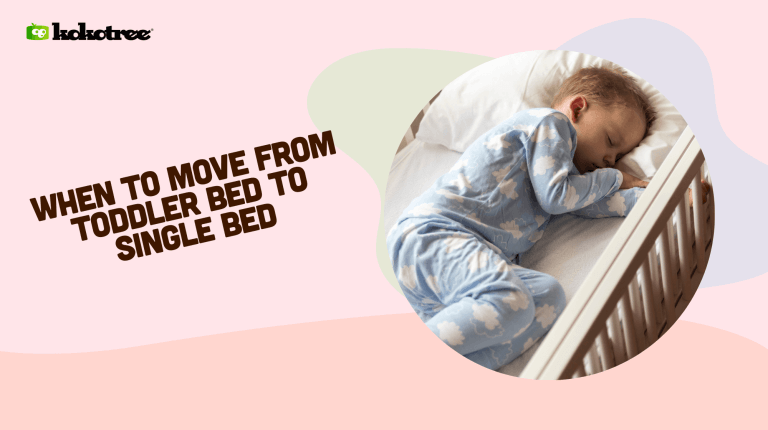

If you’re a toddler’s parent, you know how quickly your little one grows and develops. One of the most common questions that arises during this phase is when to move your child from a toddler bed to a single bed.
In this post, we’ll explore the signs that indicate it’s time for this exciting transition and offer helpful tips on how to make the change smoothly and safely. So, sit back, relax, and dive into the world of toddler bed transitions together!
Transitioning from a toddler bed to a single bed typically happens between the ages of 2 and 5. The key signs that it’s time to switch include outgrowing the toddler bed, showing interest in a bigger bed, developing motor skills like climbing, and consistently sleeping throughout the night. Pay attention to your child’s growth and development to make this change at the right time for their comfort and safety.
Toddler development plays a significant role in determining when your child is ready for a single bed. To make this transition smooth and safe, let’s take a closer look at the different stages of development and how they impact your child’s readiness to move from a toddler bed to a single bed.
As your child grows, it’s essential to ensure their safety by assessing their physical size, motor skills, and ability to navigate larger furniture items. Physical growth indicators, such as outgrowing their current bed or being too tall for the safety rails, might signal that it’s time for a new sleeping environment.
For many toddlers, emotional development is major in their feelings about bedtime and their sleep routine. They may feel a sense of attachment to their toddler bed, which must be addressed in preparation for the transition. Alternatively, if your child is excited about moving to a single bed or shows interest in other age-appropriate furniture, it might be the right time for the switch.
Children may become better equipped to handle responsibilities like adjusting to new sleeping spaces as they learn and grow. A good indicator for cognitive readiness is the ability to follow instructions and understand the new boundaries associated with having a larger bed.
Each child is unique, making it essential to watch for specific signs that they are ready to move from a toddler bed to a single bed. Here are some common indicators:
Monitor your child’s size—particularly when they approach the age of 2 or 3. If they seem to be outgrowing the toddler bed, it’s probably time to consider upgrading to a single bed. Look for physical signs like your child’s legs hanging off the end of the bed or if your child cannot find a comfortable sleep position.
Another sign your child may be ready for the change is if they frequently express interest in a bigger bed. If visiting friends or relatives with older children sparks excitement in your toddler about sleeping in a larger bed, take this as a cue that they are ready for the transition.
As their motor skills develop, you might notice that your child has started climbing over the safety bed rail or even attempting to exit their bed entirely. When your child displays these behaviors, consider moving to a single bed to ensure their safety.
If your child has been consistently sleeping through the night without incidents, they might be ready to graduate from their toddler bed to a single bed. A consistent sleep routine will ensure a smoother transition to a larger bed and minimize disruptions to their sleep schedule.
It’s essential to have a plan in place when transitioning your child from a toddler bed to a single bed. These useful tips will help make the process as smooth and safe as possible.
Make the transition more engaging by involving your child in the process of selecting a new bed, bedding, and even rearranging their bedroom if necessary. This level of involvement allows your child to feel more in control, reducing anxiety about the change.
If you’re concerned about your child abruptly transitioning from a toddler bed to a single bed, consider taking gradual steps to make the switch. Test the idea by allowing your child to nap in a single bed or sleep in one during visits to friends’ or relatives’ homes. This will make the new environment feel more familiar and reduce any worries about making the change.
Maintaining a consistent bedtime routine is key in ensuring your child’s transition to a single bed is smooth. Keep bedtime activities, such as reading a story, brushing their teeth, or using an learning app for toddlers, consistent with the routine they are accustomed to before the switch. This will help establish familiarity, making your child less likely to resist the new bedtime arrangements.
When transitioning to a single bed, setting clear boundaries and rules for your child is important. Take the time to discuss staying in their bed throughout the night, remaining in the bedroom until the morning, and safe behavior around their new bed. With clear expectations in place, your child will be more likely to adapt to the new sleeping space successfully.
Make sure to prioritize your child’s safety when planning the transition. Secure any cords or window dressings, add railings if necessary, and ensure the bed is low to the floor and has a guardrail if your child tends to roll off the bed while sleeping.
As you navigate the ups and downs of toddlerhood, it’s helpful to have reliable sources to turn to for information, advice, and activities during this period of rapid development. Take the time to explore blogs, parenting forums, books, and even educational apps for toddlers for support and inspiration. By staying informed about toddler development and seeking helpful tips and tools, you can better create a comfortable and safe environment that nurtures your child’s growth and development.
A crucial aspect of your child’s sleep journey and early childhood education is creating a positive and comforting atmosphere in their bedroom. Making the transition from a toddler bed to a single bed is an excellent opportunity to enhance the overall bedroom environment. Here are some helpful ways to promote a peaceful and nurturing sleep space:
Choose soothing colors, comforting decor, and organize the room to minimize clutter. A tidy, well-organized sleep space will help your child feel more relaxed and settle into sleep more easily.
Invest in good-quality bedding that meets your child’s preferences for comfort and warmth. Select breathable, hypoallergenic materials to ensure your child’s overall comfort and a restful night’s sleep. Remember to ask for your child’s input when purchasing bedding; they will be excited to personalize their new space.
Keep screens such as televisions, tablets, and mobile devices out of the bedroom to prevent overstimulation and promote a positive sleep environment. Encourage quieter, calming activities like reading or drawing as part of the bedtime routine, and save screen time for other areas of the house.
Provide a soft nightlight to create a comforting environment, and consider playing gentle music or white noise in the background. This can help alleviate your child’s concerns about sleeping in a larger bed and make the switch more enjoyable.
As your child grows and transitions to a single bed, it’s essential to encourage their sleep independence. Here are some tips and strategies to help your little one become more comfortable and confident in their new sleeping space:
Help your child develop a consistent bedtime routine that offers calm, comforting activities like reading bedtime stories, engaging in gentle conversation, or practicing mindfulness exercises. Establishing a routine will make your child feel safer and more at ease when it’s bedtime.
Teach your child relaxation techniques to help them calm down and fall asleep more quickly. Guided meditation, deep-breathing exercises, and progressive muscle relaxation are practical and straightforward strategies that can benefit both toddlers and parents alike in fostering a sense of calm.
Take the time to recognize your child’s successful nights in their new bed by offering words of encouragement and positive reinforcement. This will help build their confidence and make the transition more enjoyable for both of you.
Remember, transitioning from a toddler to a single bed can be exciting and nerve-wracking for your child. Be patient, understanding, and offer consistent support during this period of adjustment. By approaching this transition with empathy and encouragement, you’ll make the process smoother and more successful for everyone involved.
In this FAQ section, we’ll address some common questions and concerns related to the process of transitioning your child from a toddler bed to a single bed.
Children typically transition from a toddler bed to a single bed between the ages of 2 and 5. However, each child’s development is unique, so paying attention to their needs and readiness is essential.
Common signs include outgrowing their toddler bed, showing interest in a bigger bed, developing motor skills like climbing, and consistently sleeping through the night.
Involve your child in the process of selecting their new bed, bedding, and room arrangement. Maintain a consistent bedtime routine, establish new boundaries and rules, and take safety precautions to ensure a smooth transition.
Using a bed rail on a single bed can be a good option if your child is prone to rolling off the bed while sleeping, or if they need the extra support for a sense of security and comfort during the transition.
Create a calm and comforting environment, choose comfortable bedding, provide a soft nightlight, and encourage a consistent bedtime routine with soothing activities.
The transition might initially cause disruptions to your child’s sleep; however, if you follow the tips in this blog post, you can minimize these disruptions and maintain your child’s overall sleep quality.
Yes, a bed with storage can be used as a single bed as long as it provides adequate support, meets safety requirements, and is comfortable for your child.
Select a mattress that provides firm support, is breathable, and made of hypoallergenic materials to ensure your child’s overall comfort and a restful night’s sleep.
New bedding should be purchased when transitioning from a toddler bed to a single bed, as the sizes and requirements typically differ. Investing in good-quality, comfortable bedding can make the transition more enjoyable for your child.
A standard single bed measures approximately 75 inches in length and 39 inches in width. However, sizes can vary slightly based on mattress brand and bed frame style.
Yes, you can maintain the same theme and design for your child’s bedroom decor. However, the transition to a single bed can also be an opportunity to refresh your child’s room decor, especially if they have outgrown their current theme.
Yes, moving your child directly from a crib to a single bed is possible, provided that they meet the necessary developmental and safety requirements. Some parents choose to do this to save money and space or to minimize the number of transitions.
Establish clear expectations and rules about staying in the bed until morning, discuss the importance of remaining in the bedroom, and ensure your child understands the new boundaries associated with having a larger bed. Consistency and patience will be key in establishing successful boundaries.




